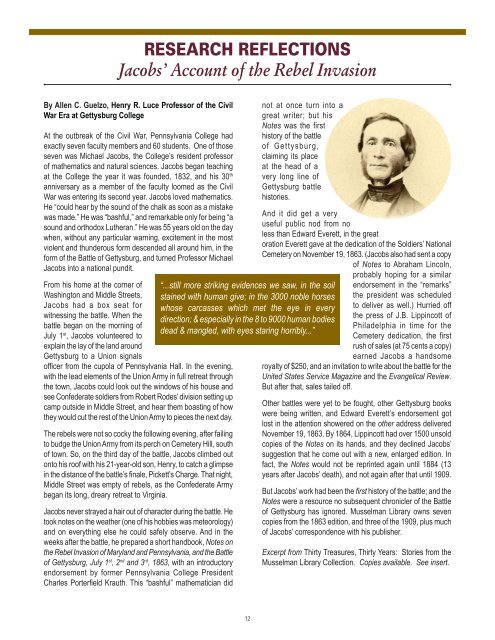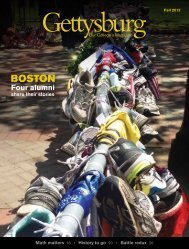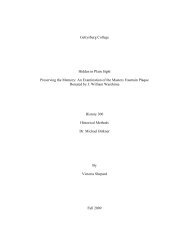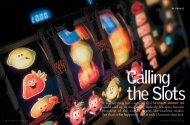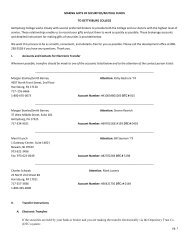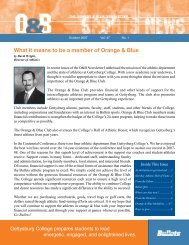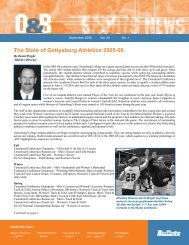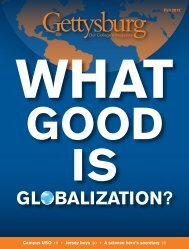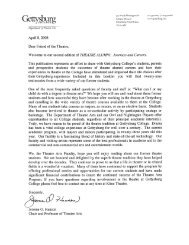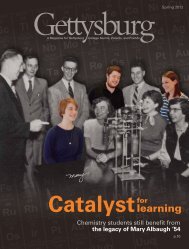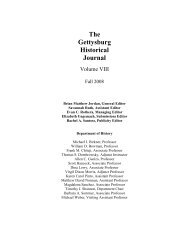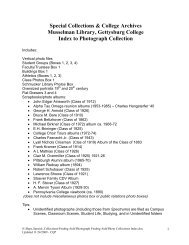Fall 2012 - Gettysburg College
Fall 2012 - Gettysburg College
Fall 2012 - Gettysburg College
Create successful ePaper yourself
Turn your PDF publications into a flip-book with our unique Google optimized e-Paper software.
EsEarch rEfLEctions<br />
Jacobs’ Account of the Rebel Invasion<br />
By Allen C. Guelzo, Henry R. Luce Professor of the Civil<br />
War Era at <strong>Gettysburg</strong> <strong>College</strong><br />
At the outbreak of the Civil War, Pennsylvania <strong>College</strong> had<br />
exactly seven faculty members and 60 students. One of those<br />
seven was Michael Jacobs, the <strong>College</strong>’s resident professor<br />
of mathematics and natural sciences. Jacobs began teaching<br />
at the <strong>College</strong> the year it was founded, 1832, and his 30 th<br />
anniversary as a member of the faculty loomed as the Civil<br />
War was entering its second year. Jacobs loved mathematics.<br />
He “could hear by the sound of the chalk as soon as a mistake<br />
was made.” He was “bashful,” and remarkable only for being “a<br />
sound and orthodox Lutheran.” He was 55 years old on the day<br />
when, without any particular warning, excitement in the most<br />
violent and thunderous form descended all around him, in the<br />
form of the Battle of <strong>Gettysburg</strong>, and turned Professor Michael<br />
Jacobs into a national pundit.<br />
From his home at the corner of<br />
Washington and Middle Streets,<br />
Jacobs had a box seat for<br />
witnessing the battle. When the<br />
battle began on the morning of<br />
July 1 st , Jacobs volunteered to<br />
explain the lay of the land around<br />
<strong>Gettysburg</strong> to a Union signals<br />
officer from the cupola of Pennsylvania Hall. In the evening,<br />
with the lead elements of the Union Army in full retreat through<br />
the town, Jacobs could look out the windows of his house and<br />
see Confederate soldiers from Robert Rodes’ division setting up<br />
camp outside in Middle Street, and hear them boasting of how<br />
they would cut the rest of the Union Army to pieces the next day.<br />
The rebels were not so cocky the following evening, after failing<br />
to budge the Union Army from its perch on Cemetery Hill, south<br />
of town. So, on the third day of the battle, Jacobs climbed out<br />
onto his roof with his 21-year-old son, Henry, to catch a glimpse<br />
in the distance of the battle’s finale, Pickett’s Charge. That night,<br />
Middle Street was empty of rebels, as the Confederate Army<br />
began its long, dreary retreat to Virginia.<br />
Jacobs never strayed a hair out of character during the battle. He<br />
took notes on the weather (one of his hobbies was meteorology)<br />
and on everything else he could safely observe. And in the<br />
weeks after the battle, he prepared a short handbook, Notes on<br />
the Rebel Invasion of Maryland and Pennsylvania, and the Battle<br />
of <strong>Gettysburg</strong>, July 1 st , 2 nd and 3 rd , 1863, with an introductory<br />
endorsement by former Pennsylvania <strong>College</strong> President<br />
Charles Porterfield Krauth. This “bashful” mathematician did<br />
12<br />
not at once turn into a<br />
great writer; but his<br />
Notes was the first<br />
history of the battle<br />
of <strong>Gettysburg</strong>,<br />
claiming its place<br />
at the head of a<br />
very long line of<br />
<strong>Gettysburg</strong> battle<br />
histories.<br />
“...still more striking evidences we saw, in the soil<br />
stained with human give; in the 3000 noble horses<br />
whose carcasses which met the eye in every<br />
direction; & especially in the 8 to 9000 human bodies<br />
dead & mangled, with eyes staring horribly...”<br />
And it did get a very<br />
useful public nod from no<br />
less than Edward Everett, in the great<br />
oration Everett gave at the dedication of the Soldiers’ National<br />
Cemetery on November 19, 1863. (Jacobs also had sent a copy<br />
of Notes to Abraham Lincoln,<br />
probably hoping for a similar<br />
endorsement in the “remarks”<br />
the president was scheduled<br />
to deliver as well.) Hurried off<br />
the press of J.B. Lippincott of<br />
Philadelphia in time for the<br />
Cemetery dedication, the first<br />
rush of sales (at 75 cents a copy)<br />
earned Jacobs a handsome<br />
royalty of $250, and an invitation to write about the battle for the<br />
United States Service Magazine and the Evangelical Review.<br />
But after that, sales tailed off.<br />
Other battles were yet to be fought, other <strong>Gettysburg</strong> books<br />
were being written, and Edward Everett’s endorsement got<br />
lost in the attention showered on the other address delivered<br />
November 19, 1863. By 1864, Lippincott had over 1500 unsold<br />
copies of the Notes on its hands, and they declined Jacobs’<br />
suggestion that he come out with a new, enlarged edition. In<br />
fact, the Notes would not be reprinted again until 1884 (13<br />
years after Jacobs’ death), and not again after that until 1909.<br />
But Jacobs’ work had been the first history of the battle; and the<br />
Notes were a resource no subsequent chronicler of the Battle<br />
of <strong>Gettysburg</strong> has ignored. Musselman Library owns seven<br />
copies from the 1863 edition, and three of the 1909, plus much<br />
of Jacobs’ correspondence with his publisher.<br />
Excerpt from Thirty Treasures, Thirty Years: Stories from the<br />
Musselman Library Collection. Copies available. See insert.


